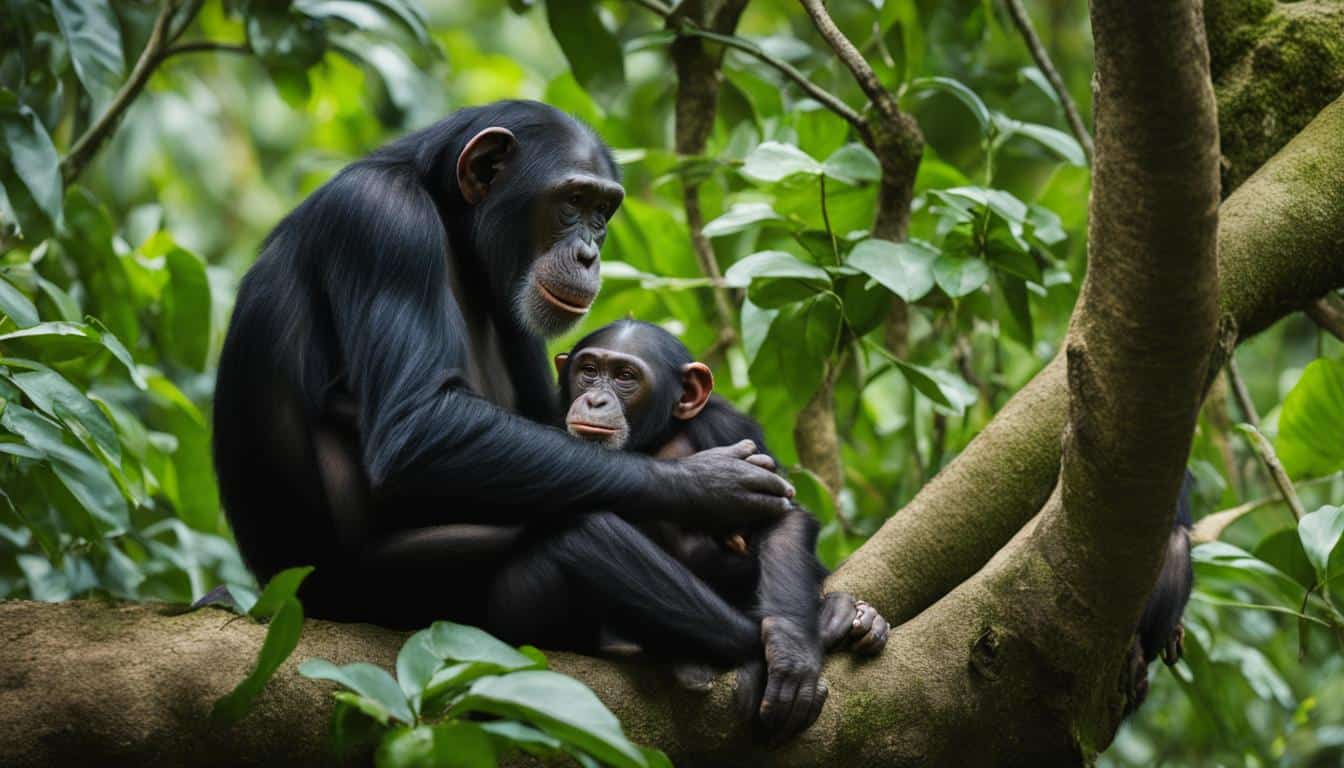Chimpanzees have fascinating grooming habits and behaviors that contribute to their overall well-being. In this article, we will explore the social grooming in chimpanzees, their grooming behavior, and how it helps maintain their hygiene.
Grooming is a crucial part of a chimpanzee’s daily routine. It serves multiple purposes, including achieving cleanliness by removing dirt, plants, dried skin, and bugs from their hair. It also helps them maintain their appearances, as a well-groomed chimp looks tidier compared to one that hasn’t been groomed.
Chimps engage in grooming sessions in higher spaces, such as outdoor platforms, where they can gather in larger groups. These grooming sessions are not just about hygiene; they are vital social interactions that help chimpanzees maintain status, build friendships, and strengthen bonds within their group. By understanding their grooming habits and behavior, we gain deeper insights into the fascinating world of our closest relatives and their social dynamics.
Grooming: The Key to Social Behavior in Chimpanzees
Grooming rituals play a crucial role in the social behavior of chimpanzees. These grooming patterns are not merely about hygiene but are essential for establishing and strengthening social bonds within the group. Chimpanzees engage in grooming interactions as a means of building trust, maintaining status, and fostering friendships.
During grooming sessions, chimps form close bonds by being in close proximity and exhibiting trust towards one another. These interactions can last anywhere from a few minutes to several hours, providing ample time for individuals to exchange not only physical care but also social affection. Grooming is a shared experience that fosters a sense of community among chimpanzees, allowing them to build a network of relationships within their social group.
“Grooming is not only beneficial for social interactions but also provides relaxation for the chimps, similar to how humans perform self-care techniques,” says Dr. Jane Goodall, renowned primatologist.
Grooming is not limited to its social benefits; it also has hygienic advantages for chimpanzees. By removing dirt, insects, parasites, and tangles from their fur, chimps keep their skin and hair in good condition. The act of grooming is often reciprocated, with the groomee becoming the groomer, reinforcing the bond between individuals. This reciprocal grooming helps maintain a healthy social structure within chimpanzee communities, ensuring the well-being and cohesion of the group.
| Grooming Rituals | Grooming Patterns | Grooming Interactions |
|---|---|---|
| Establish and strengthen social bonds | Remove dirt, insects, parasites, and tangles | Build trust and maintain status |
| Create a sense of community | Reciprocated grooming reinforces bonds | Foster friendships within the group |
Grooming is a fundamental aspect of chimpanzee social behavior, providing both physical and emotional benefits. By engaging in grooming rituals, chimpanzees not only enhance their hygiene but also foster strong social connections, enabling them to navigate their dynamic social structures and maintain harmonious relationships.
The Hygienic Benefits of Grooming in Chimpanzees
Chimpanzees engage in grooming behavior not just for social bonding but also for hygienic purposes. Grooming helps them remove dirt, insects, parasites, dead skin, and tangles from their fur, keeping their skin and hair in good condition. It is a meticulous process that involves the use of fingers and teeth to carefully groom each other.
One of the interesting aspects of chimpanzee grooming is the reciprocity involved. The act of grooming is often reciprocated, creating a mutually beneficial relationship where both individuals take turns being the groomee and the groomer. This reciprocal grooming not only helps them maintain cleanliness but also fosters bonds within the group.
“Grooming is an essential part of our daily routine. It not only keeps us clean but also strengthens our bonds with other group members. We take turns grooming each other, and it’s a comforting and relaxing activity for us,” says Dr. Jane Goodall, renowned primatologist.
Chimpanzees have preferred grooming groups within their communities. They often gather in higher spaces, such as outdoor platforms, where they can groom in larger groups. This allows them to engage in social interactions while maintaining cleanliness. Additionally, grooming in groups provides them with protection against insects and other external threats.
| Grooming Habits | Preferred Grooming Areas |
|---|---|
| Chimpanzees groom each other to remove dirt and maintain hygiene. | Outdoor platforms where they can gather in larger groups. |
| Grooming behavior is reciprocal, strengthening bonds within the group. | Indoor spaces in chimpanzee sanctuaries. |
| Grooming helps chimps relax and relieve stress. | Anywhere in the group’s territory. |
In conclusion, grooming in chimpanzees serves hygienic purposes by removing dirt and maintaining cleanliness. It is a reciprocal behavior that fosters bonds within the group and provides relaxation for the individuals involved. Preferred grooming areas vary depending on the circumstances, but higher spaces and platforms are often favored by chimpanzees. By understanding the hygienic benefits of grooming, we gain deeper insights into the fascinating world of chimpanzee behavior and social dynamics.
Grooming and Social Bonding in Chimpanzees
Grooming is not just about hygiene for chimpanzees; it also serves as a way to establish and strengthen social bonds. Chimpanzees remember and share more food with individuals who have groomed them in the past. This reciprocity builds trust and fosters closer relationships among group members. Vocalizations and soliciting postures are used to indicate desires for grooming and to communicate intentions between individuals. In lower-ranked individuals, grooming higher-ranked individuals can lead to increased acceptance and protection within the group.
Grooming interactions among chimpanzees are crucial for maintaining the social fabric within their communities. These interactions allow chimps to build social connections, resolve conflicts, and establish hierarchies. By engaging in grooming behaviors, chimpanzees are able to demonstrate trust and cooperation, which are essential for their survival and well-being. The act of grooming not only strengthens existing social bonds but also creates opportunities for new relationships to form.
“Grooming is a fundamental aspect of chimpanzee social behavior. It allows individuals to establish and maintain social bonds, resolve conflicts, and communicate their intentions. Through grooming, chimps are able to build trust and form alliances within their groups.”
Grooming and Bonding in Chimpanzee Communities
Research has shown that grooming plays a significant role in the social dynamics of chimpanzee communities. It promotes cooperation, reduces tension, and fosters a sense of belonging among group members. Grooming not only benefits the individuals involved but also helps to maintain a stable and cohesive social structure within the group. It is through grooming interactions that chimpanzees are able to navigate the complexities of their social relationships and maintain a harmonious coexistence.
| Grooming and social bonding in Chimpanzees | |
|---|---|
| Chimpanzees remember and share more food with individuals who have groomed them in the past. | Building trust and fostering closer relationships among group members. |
| Grooming interactions allow chimps to build social connections, resolve conflicts, and establish hierarchies. | Strengthening existing social bonds and creating opportunities for new relationships to form. |
| Grooming promotes cooperation, reduces tension, and fosters a sense of belonging among group members. | Maintaining a stable and cohesive social structure within the group. |
Grooming is a fundamental aspect of chimpanzee social behavior. It allows individuals to establish and maintain social bonds, resolve conflicts, and communicate their intentions. Through grooming, chimps are able to build trust and form alliances within their groups. By understanding the importance of grooming in chimpanzee communities, we gain a deeper appreciation for the complex social dynamics of these incredible animals.
Grooming as a Relaxing Activity for Chimpanzees
Grooming is not just a hygienic activity for chimpanzees; it also provides a sense of relaxation and comfort. Similar to how humans enjoy a soothing massage, grooming allows chimpanzees to unwind and let off steam. During grooming sessions, the chimps often become more calm and relaxed, resulting in a peaceful and tranquil atmosphere.
Research has shown that grooming can have a therapeutic effect on chimpanzees. It stimulates the release of endorphins, which are natural feel-good hormones that promote relaxation and reduce stress. The gentle touch and rhythmic grooming movements create a soothing experience for the chimps, helping them to unwind and find comfort.
“Grooming is a way for chimpanzees to engage in self-care and promote their overall well-being. It’s like a spa treatment for them,” says Dr. Jane Goodall, renowned primatologist and chimpanzee expert.
Chimpanzees often seek out grooming partners, both for the physical benefits and the emotional connection it provides. By engaging in grooming sessions, they not only keep themselves clean but also strengthen their social bonds and reinforce their relationships with other group members. It is a mutually beneficial activity that promotes trust, cooperation, and a sense of community within the chimpanzee group.
Overall, grooming serves as a vital form of relaxation for chimpanzees, allowing them to take care of their physical and emotional well-being. It is a fascinating behavior that highlights the complex social dynamics and self-care practices of our closest relatives in the animal kingdom.

| Grooming as a Relaxing Activity for Chimpanzees | Benefits |
|---|---|
| 1. Promotes relaxation | Stimulates the release of endorphins, reducing stress and creating a calm atmosphere. |
| 2. Soothing experience | The gentle touch and rhythmic grooming movements provide comfort and a sense of well-being. |
| 3. Therapeutic effect | Helps chimpanzees unwind and find comfort, similar to a spa treatment. |
| 4. Strengthens social bonds | Grooming promotes trust, cooperation, and a sense of community within the chimpanzee group. |
Preferred Locations for Grooming in Chimpanzees
Chimpanzees have specific preferences when it comes to grooming locations. While most chimps at the sanctuary prefer grooming in higher spaces, such as outdoor platforms, they are adaptable and will utilize any opportunity for grooming, whether indoors or outdoors. The choice of location may vary depending on the circumstances, but grooming is a constant activity for chimps regardless of the time of day.
Grooming sessions in higher spaces like outdoor platforms not only allow for larger grooming groups but also provide the chimps with an opportunity to enjoy the outdoors while engaging in social interactions. These elevated spaces offer a sense of security for the chimps as they groom, helping them establish stronger bonds within the group. Whether it’s a sunny day or a quiet evening, chimps make the most of these preferred grooming areas.
Indoor grooming also has its advantages. It provides a comfortable and sheltered environment for chimps to engage in grooming sessions, especially during unfavorable weather conditions. Indoor spaces offer a sense of familiarity and can be a quieter setting for chimps who prefer a more relaxed grooming experience. Whether it’s a spacious enclosure or a designated grooming area, indoor locations cater to the different grooming preferences of chimpanzees.
Chimpanzees have adapted to groom in various locations, both indoors and outdoors, based on their individual preferences and the availability of suitable spaces. These locations play a significant role in facilitating social bonding and maintaining overall well-being within chimpanzee communities.
| Grooming Locations | Description |
|---|---|
| Outdoor platforms | Higher spaces that allow for larger groups and outdoor enjoyment |
| Indoor enclosures | Comfortable and sheltered areas for grooming during unfavorable weather |
In conclusion, chimps display a clear preference for grooming in higher spaces like outdoor platforms while also making use of indoor locations. These preferred grooming areas cater to their social and comfort needs, allowing them to engage in this essential behavior to establish and strengthen social bonds within their communities.
Conclusion
Chimpanzees have fascinating grooming habits and behaviors that serve multiple purposes. Not only does grooming help them achieve cleanliness by removing dirt, plants, and bugs from their hair, but it also helps them maintain their appearances and establish social bonds within their group.
Grooming is a crucial social interaction for chimpanzees, allowing them to maintain their status, build friendships, and strengthen their relationships. Through grooming, chimps engage in reciprocal behavior, creating bonds that contribute to the overall health and well-being of their communities.
Furthermore, grooming provides hygienic benefits, as it helps chimps reach areas that are harder to clean on their own. It keeps their skin and hair in good condition, ensuring their overall health and comfort.
By understanding the grooming rituals and patterns of chimpanzees, we gain deeper insights into their complex social behavior. These incredible creatures use grooming not only to maintain hygiene but also as a way to connect, communicate, and find solace in each other’s presence.
What are the grooming habits of chimpanzees and how do they maintain their hygiene?
Chimpanzee grooming habits play a crucial role in their social structure. They use tools like sticks to clean each other’s fur and remove parasites. This not only helps maintain hygiene but also strengthens social bonds within the group. Grooming also helps regulate body temperature and reduce stress.
FAQ
How do chimpanzees groom and maintain their hygiene?
Chimpanzees groom each other to achieve cleanliness by removing dirt, plants, dried skin, and bugs from their hair. Grooming helps them maintain their appearances and keep their skin and hair in good condition.
What is the importance of grooming for chimpanzee social behavior?
Grooming plays a vital role in chimpanzee social behavior as it helps them maintain status within the group, build friendships, and strengthen bonds. It is a crucial social interaction that contributes to the overall well-being of chimpanzee communities.
What are the hygienic benefits of grooming in chimpanzees?
Grooming serves hygienic purposes for chimpanzees by helping them remove dirt, insects, parasites, dead skin, and tangles from their fur. It keeps their skin and hair in good condition and contributes to their overall cleanliness.
How does grooming contribute to social bonding in chimpanzees?
Grooming is used by chimpanzees as a way to establish and strengthen social bonds. It builds trust and fosters closer relationships among group members, and individuals often remember and share more food with those who have groomed them in the past.
Is grooming a relaxing activity for chimpanzees?
Yes, grooming provides a sense of comfort and relaxation for chimpanzees. It can be compared to a full body massage for humans and allows them to let off steam while simultaneously keeping themselves clean.
Where do chimpanzees prefer to groom?
Chimpanzees have preferred areas for grooming, with most of them preferring higher spaces such as outdoor platforms. These spaces allow for larger grooming groups and the opportunity to enjoy the outdoors while engaging in grooming sessions.







